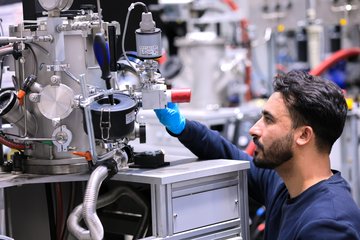All genres
41.
Journal Article
(Nbx, Zr1-x)4AlC3 MAX Phase Solid Solutions: Processing, Mechanical Properties, and Density Functional Theory Calculations. Inorganic Chemistry 55 (11), pp. 5445 - 5452 (2016)
42.
Journal Article
Combined atom probe tomography and density functional theory investigation of the Al off-stoichiometry of κ-carbides in an austenitic Fe–Mn–Al–C low density steel. Acta Materialia 106, pp. 229 - 238 (2016)
43.
Journal Article
Atom probe tomography of interfaces in ceramic films and oxide scales. MRS Bulletin 41 (1), pp. 35 - 39 (2016)
44.
Journal Article
Phase selection and nanocrystallization in Cu-free soft magnetic FeSiNbB amorphous alloy upon rapid annealing. Journal of Applied Physics 119, 124903 (2016)
45.
Journal Article
Elemental partitioning, lattice misfit and creep behaviour of Cr containing γ′ strengthened Co base superalloys. Materials Science and Technology 32 (3), pp. 220 - 225 (2016)
46.
Journal Article
Impact of annealing on electrical properties of Cu2ZnSnSe4 absorber layers. Journal of Applied Physics 120, 045703 (2016)
47.
Journal Article
Mining information from atom probe data. Ultramicroscopy 159, pp. 324 - 337 (2015)
48.
Journal Article
Guided mass spectrum labelling in atom probe tomography. Ultramicroscopy 159 (2), pp. 338 - 345 (2015)
49.
Journal Article
Atomic scale investigation of non-equilibrium segregation of boron in a quenched Mo-free martensitic steel. Ultramicroscopy 159, pp. 240 - 247 (2015)
50.
Journal Article
Synergy of atom-probe structural data and quantum-mechanical calculations in a theory-guided design of extreme-stiffness superlattices containing metastable phases. New Journal of Physics 17 (9), 093004 (2015)
51.
Journal Article
Homogeneity and composition of AlInGaN: A multiprobe nanostructure study. Ultramicroscopy 156, pp. 29 - 36 (2015)
52.
Journal Article
Effect of ruthenium on the precipitation of topologically close packed phases in Ni-based superalloys of 3rd and 4th generation. Acta Materialia 95, pp. 274 - 283 (2015)
53.
Journal Article
The role of grain boundaries in the initial oxidation behavior of austenitic stainless steel containing alloyed Cu at 700 °C for advanced thermal power plant applications. Corrosion Science 96, pp. 52 - 66 (2015)
54.
Journal Article
Atom probe informed simulations of dislocation–precipitate interactions reveal the importance of local interface curvature. Acta Materialia 92, pp. 33 - 45 (2015)
55.
Journal Article
Combining structural and chemical information at the nanometer scale by correlative transmission electron microscopy and atom probe tomography. Ultramicroscopy 153, pp. 32 - 39 (2015)
56.
Journal Article
The nucleation of Mo-rich Laves phase particles adjacent to M23C6 micrograin boundary carbides in 12% Cr tempered martensite ferritic steels. Acta Materialia 90, pp. 94 - 104 (2015)
57.
Journal Article
Deformation induced alloying in crystalline – metallic glass nano-composites. Materials Science and Engineering A: Structural Materials Properties Microstructure and Processing 628, pp. 269 - 280 (2015)
58.
Journal Article
Dynamic strain aging studied at the atomic scale. Acta Materialia 86, pp. 34 - 42 (2015)
59.
Journal Article
Thermal dissolution mechanisms of AlN/CrN hard coating superlattices studied by atom probe tomography and transmission electron microscopy. Acta Materialia 85, pp. 32 - 41 (2015)
60.
Journal Article
Effects of Ru on elemental partitioning and precipitation of topologically close-packed phases in Ni-based superalloys. Scripta Materialia 101, pp. 44 - 47 (2015)











